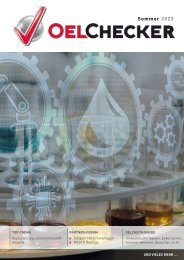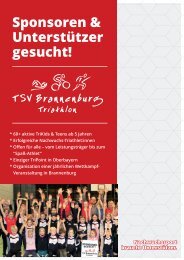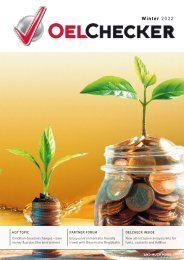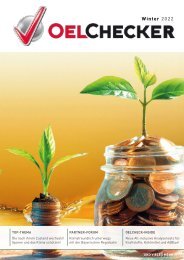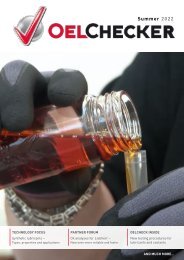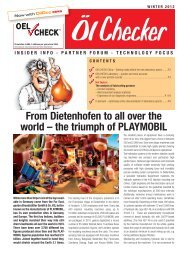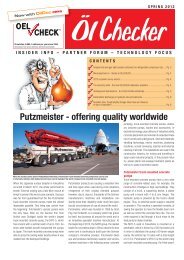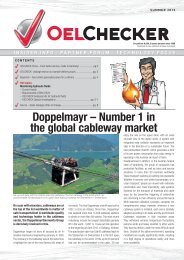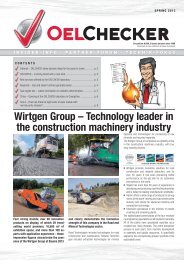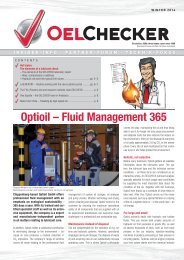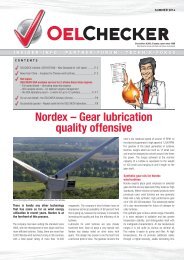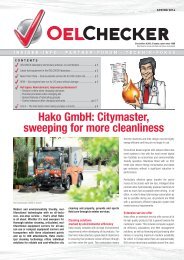OELCHECKER - Summer 2012
> Prokon wind turbines – optimum service and secure earnings > OELCHECK laboratory in the "workbench of the world" domain > The rappers from the OELCHECK alpine pastures > Optimised technology and perfect service for gas engines – August Storm > Hot Topics: > Viscosity – the single most important physical characteristic of any oil > Question time: Limit values > and much more...
> Prokon wind turbines – optimum service and secure earnings
> OELCHECK laboratory in the "workbench of the world" domain
> The rappers from the OELCHECK alpine pastures
> Optimised technology and perfect service for gas engines – August Storm
> Hot Topics:
> Viscosity – the single most important physical characteristic of any oil
> Question time: Limit values
> and much more...
You also want an ePaper? Increase the reach of your titles
YUMPU automatically turns print PDFs into web optimized ePapers that Google loves.
Now with OilDoc news<br />
SUMMER <strong>2012</strong><br />
Circulation: 9,000, 3 editions a year since 1998<br />
Download from www.oelcheck.de/news-downloads<br />
INSIDER INFO – PARTNER FORUM – TECHNOLOGY FOCUS<br />
CONTENTS<br />
OELCHECK laboratory in the “workbench of the world” domain ............. P. 3<br />
The rappers from the OELCHECK alpine pastures ................................. P. 3<br />
Optimised technology and perfect service for gas engines –<br />
August Storm ...................................................................................... P. 4<br />
Top topic:<br />
Viscosity – the single most important physical characteristic of any oil ... P. 5<br />
Question time: Limit values .................................................................. P. 8<br />
Meet the team! ................................................................................... P. 8<br />
Prokon wind turbines –<br />
optimum service and secure earnings<br />
Since 2002, Prokon has been maintaining, servicing<br />
and repairing the company’s wind turbines. And<br />
since 2011, its own employees have been replacing<br />
and reconditioning large components, such as<br />
gearboxes and generators. In addition, maintenance<br />
and servicing operations are carried out for the six<br />
in-house substations and their transfer stations and<br />
transformer stations. Prokon is able to guarantee<br />
reliable operations and maximum efficiency for the<br />
wind turbines with the in-house Technical Service.<br />
In the long term, this should mean higher earnings<br />
for the investors.<br />
The company runs 47 wind farms with 289 wind<br />
turbines, of which 38 wind farms and 266 turbines<br />
are in six German states with the other nine wind<br />
farms and 23 turbines in Poland. From 1995 until<br />
spring of <strong>2012</strong>, installed output was 479 MW<br />
producing a total of approximately five billion kWh.<br />
More turbines are either being planned or are currently<br />
being constructed.<br />
Prokon generates high earnings for its 50,000+ investors. Reliable operations and maximum efficiency for the turbines are guaranteed<br />
by the the in-house Technical Service.<br />
The Prokon group was founded in October<br />
1995. Today it has over 16 years of<br />
experience in project planning, funding,<br />
implementation and commercial business<br />
management and the technical operational<br />
management of projects in the<br />
area of renewable sources of energy and<br />
the sustainable use of natural resources.<br />
Over 50,000 investors now have a stake<br />
in the company’s success with Prokon<br />
participation rights. Subscribed capital<br />
will soon hit one billion EUROs.<br />
Once a wind turbine has been brought into service,<br />
Prokon takes over the technical operational management.<br />
This includes: monitoring of the turbine’s<br />
condition including data remote monitoring, communication<br />
with the turbine manufacturer, inspection<br />
and tracking of the turbine manufacturer’s<br />
work, progress review for routine checks, execution<br />
or commissioning of safety-related checks (building<br />
cradle, crane, ladder, fire extinguisher, etc.),<br />
analysis of error frequency, performance charac-
The world of OELCHECK is truly international. Alone in our team<br />
in Brannenburg, in addition to our German employees, we have<br />
people from Bosnia, Kazakhstan, Kenya, Austria, Poland and<br />
Russia. In the autumn of this year, new colleagues from China will<br />
be visiting for training. The OELCHECK world is wonderfully huge<br />
and colourful with lots of fascinating characters. In our daily dealings<br />
with each other, we learn about lots of new customs, practices<br />
and attitudes towards life. That means that we have no preconceptions<br />
about people and are an open and curious team. We all<br />
benefit personally from our approach and can learn a lot of things<br />
that enrich our lives and broaden our horizons. Although we may all<br />
have a different ancestry, what matters is that we are all striving<br />
for the same goal: to deliver the highest level of service for all our customers, irrespective of where<br />
they are based.<br />
Agility, flexibility and, above all, an enjoyment of working with other people are what’s needed<br />
when we welcome visitors from other countries or take part in trade fairs and working groups<br />
in the USA, Russia, China or elsewhere. We are particularly excited about 22 January 2013<br />
because that’s the day that the second OilDoc Conference and Exhibition in Rosenheim will be opening<br />
its doors! In 2011 we had over 400 participants from 24 countries. We are looking forward to<br />
welcoming the many visitors, speakers and exhibitors from all over the world who will be giving topclass<br />
presentations and exchanging information with everyone there!<br />
Yours, Barbara Weismann<br />
teristics and technical availability, commissioning or<br />
drawing-up of expert reports as well as inspection<br />
of expert report processing.<br />
At the end of the guarantee period, the repair work<br />
(maintenance and servicing) is also undertaken<br />
by Prokon. That’s why service points with materials<br />
stores have been built in Schleswig-Holstein,<br />
Brandenburg, Saxony-Anhalt and Rheinland-Pfalz<br />
to ensure fast reaction times and high-tech availability.<br />
In total there are 21 service teams available<br />
for maintenance and service work including large<br />
component replacement and repair work on the<br />
wind turbines.<br />
Prokon offers a gear and hydraulic oil change service<br />
for wind turbines all across Germany. A special<br />
oil change vehicle can deliver up to four different<br />
oils by type per application. Therefore the company<br />
can also carry out the oil service on its own wind<br />
turbines. Oil changes are carried out according to<br />
manufacturer specifications or depending on the<br />
condition of the oil based on oil analyses.<br />
Multipurpose HVLP 32 hydraulic fluids are used<br />
in the wind turbines. By choosing them, Prokon is<br />
complying with component manufacturers’ specifications<br />
and preferred suppliers lists, individual system<br />
requirements as well as operating conditions<br />
and is placing importance on high quality. Hydraulic<br />
oil fills depend on turbine designs and range from<br />
15 to 315 litres. The hydraulics system, for example,<br />
optimises rotor blade performance, tracks the wind,<br />
brakes the drive train and even keeps the nacelle<br />
in position in the event of crosswinds. Therefore<br />
not only are safety aspects fulfilled but also the<br />
energy output from the wind and hence the efficiency<br />
of a turbine can be controlled. In the event of<br />
particularly strong winds, there can sometimes be<br />
very high loads applied to the hydraulic oil. Above<br />
all, its viscosity must remain stable over a broad<br />
temperate application range and when faced with<br />
changing pressure loads of over 300 bar. HVLP hydraulic<br />
oils stand out due to a high viscosity index of<br />
over 180. Economically priced oils can also reach<br />
such a high VI with multipurpose additives. However,<br />
these are often not shear-stable. Their VI can<br />
drastically fall, for example, from 200 to 120 after<br />
just 50 hours of service. In turn, the viscosity falls<br />
from approx. 32 mm²/s to less than 25 mm²/s at<br />
40°C which means that the oil becomes far too thin.<br />
The consequences for the hydraulics system can be<br />
serious. If the number of internal leaks is too high,<br />
for example, the oil can no longer delivery sufficient<br />
braking force. Due to adjusting mechanisms that<br />
have become inaccurate, the whole turbine ceases<br />
to work efficiently. Such lower-quality hydraulic oils<br />
are definitely not designed for wind turbines.<br />
Prokon errs on the side of caution and intentionally<br />
uses only high-quality HVLP 32 hydraulic oils with<br />
multipurpose characteristics, because they:<br />
• are very fluid, even at very low temperatures<br />
below -25°C<br />
• contain shear-stable viscosity index improvers<br />
• ensure maximum efficiency at operating temperatures<br />
of over 60°C and operating pressures<br />
of over 350 bar.<br />
Besides hydraulic oils and gear oils, main bearing<br />
lubricating greases are also regularly checked<br />
by Prokon and their relubrication intervals are<br />
optimised.<br />
If the operating parameters are no longer right,<br />
a problem which can manifest itself as unusual<br />
changes in the lubricants, there can be serious<br />
financial consequences. Therefore, since 2000,<br />
the company has been using OELCHECK lubricant<br />
analyses in order to find out about any damage<br />
to the components and changes in the lubricants’<br />
characteristics early as part of its monitoring operations.<br />
This way, the lubricants can be changed<br />
according to the condition that they are in and<br />
costs can be reduced. Monitoring hydraulic fluids is<br />
also not the only area where OELCHECK lubricant<br />
analyses have repeatedly excelled. Together with<br />
vibration measurements, they form an important<br />
element of condition monitoring for gearboxes. If<br />
there are noticeable signs of wear in the oil test<br />
and therefore damage to a gearbox’s bearing or<br />
gearing, Prokon can immediately carry out a gearbox<br />
endoscopy. Over the last few years, thanks to<br />
OELCHECK lubricant analyses, a few wear problems<br />
have been discovered early. Prokon was able<br />
to plan the repair work properly and considerably<br />
minimise the financial burden.<br />
Prokon currently operates 47 wind farms with 289 wind turbines. More turbines are at the planning stage.
OELCHECK INSIDER INFO<br />
OELCHECK laboratory in the “workbench of the world” domain<br />
We couldn’t have picked a better location for our<br />
new laboratory in China. Guangzhou, the old canton,<br />
right next to Hong Kong in the south-east of<br />
the People’s Republic of China, is the capital of the<br />
Guangdong province. This is where the industrialisation<br />
of China began back in the late seventies.<br />
After Beijing and Shanghai, this is still where the<br />
country’s strongest economic growth is. Over 150<br />
million people live and work in an area spanning<br />
200 km. So many industrial companies are based<br />
in the region that the Guangdong province has also<br />
become known as the “extended workbench of the<br />
world”. This city, which is rich in tradition, plays<br />
host to China’s largest trade fairs every spring and<br />
autumn. It takes just one and a half hours to get to<br />
Guangzhou and our new laboratory from any of the<br />
three international airports, Hong Kong, Shenzhen<br />
and Guangzhou. The official opening is expected to<br />
take place just before the Chinese New Year celebrations<br />
in January 2013.<br />
We have acquired a large part of the third floor,<br />
covering approx. 550 square metres, in one of the<br />
two 38-storey towers of the Tian’an Headquarter<br />
Economic Center. Preparations for the installation of<br />
the new laboratory are already well underway. It’s<br />
just the company registration that is not as straightforward<br />
as in Europe. But it should all be finished<br />
within three months. In the meantime, we are installing<br />
and linking up all the laboratory equipment<br />
in the OELCHECK headquarters in Brannenburg.<br />
Extensive test runs to train the Chinese laboratory<br />
technicians have been scheduled to ensure that everything<br />
works just as it does in the main laboratory<br />
in Germany. In addition, all devices and processes<br />
will be integrated into our Laboratory Information and<br />
Management System. In terms of quality assurance,<br />
this is an absolute must. When the laboratory equipment<br />
has arrived in China and has been installed and<br />
tested on-site again by our German colleagues, we<br />
will get the official ISO 9001 and ISO 14001 certifications<br />
and the ISO/IEC 17025 accreditation, fulfilling<br />
the general expertise requirements for test and<br />
calibration laboratories. We also plan to be certified<br />
by CNAS, the China National Accreditation Service<br />
for Conformity Assessment.<br />
This year, our Chinese colleagues are taking extensive<br />
training at the OELCHECK laboratory in<br />
Brannenburg. They will be getting to grips with the<br />
equipment that will be in their new laboratory and the<br />
work processes. Laboratory manager William Wang<br />
Wei Dong, who studied in Wuhan, has a bachelor’s<br />
degree in Lubricants and Tribology. He has extensive<br />
industry knowledge and has already set up a<br />
lubricants analysis laboratory in China which he ran<br />
successfully for several years. Andrew Zeng An, who<br />
graduated from Hunan University as a mechanical<br />
engineer, will be in charge of marketing. He has<br />
worked for several years in a laboratory for used oil<br />
analysis and, amongst other functions, commented<br />
on analysis results. With his extensive technical<br />
know-how, he’ll not only be able to tap new potential<br />
business areas but he’ll also be qualified to answer<br />
queries. These two gentlemen will be supported by<br />
laboratory technicians ad technical secretaries.<br />
It was high time for an<br />
OELCHECK laboratory<br />
in China!<br />
New machines are being imported<br />
from Germany. More and more European companies<br />
are setting up branches in China. Of the 5,000<br />
German companies with subsidiary companies<br />
in China, over 2,000 are already OELCHECK<br />
customers. In addition to the usual questions, they<br />
and many other industrial companies want to know<br />
whether, for instance, the lubricants available<br />
in China are as good as those recommended in<br />
Germany. To date, there has been no comparable<br />
service available in the Far East. Indeed, there are a<br />
few laboratories which ascertain selected oil values,<br />
but such extensive tests, useful laboratory reports<br />
and comments on lubricants and their continued<br />
use, such as those provided by OELCHECK, are<br />
simply not available. However, at the same time,<br />
more and more Chinese companies are taking a<br />
proactive approach to maintenance. Hence, over the<br />
last few years, we have been receiving an increasing<br />
number of requests for lubricants analyses<br />
from Asia. However, transporting the specimens all<br />
the way to Brannenburg takes too long and is too<br />
expensive. So now we will be able to accommodate<br />
the needs of our clients.<br />
When the OELCHECK laboratory in Guangzhou<br />
starts operations in 2013, all lubricant samples<br />
will be tested with the same devices and to the<br />
same standards as in Brannenburg. The established<br />
values will be immediately sent to our diagnosis<br />
engineers in Germany by data line. They will<br />
interpret the results individually and as a whole,<br />
taking machine and oil type, operational conditions<br />
and previous analyses into account. Customers<br />
will receive their laboratory reports in Chinese<br />
within 48 hours. All individual laboratory reports<br />
and sample data are available for our customers<br />
worldwide at any time on our online platform at<br />
www.laborberichte.com.<br />
NEW<br />
The rappers from the OELCHECK alpine pastures<br />
This time, our team event took us to the Hohenegg<br />
Alps in the Allgäu. On Friday 27 July, early in the<br />
morning we went to Oberstaufen. From there we<br />
took the train up the mountain and, after a short<br />
walk, reached our destination. After a delicious<br />
lunch, we completed the orienteering adventure<br />
course, in glorious weather, with its many challenges<br />
such as archery, a milking competition and<br />
team standing see-saw. In between all of that,<br />
each of our six teams prepared for their evening<br />
performances as rapper groups. When we got<br />
started with the BBQ in the evening by the huge<br />
campfire, the atmosphere was just perfect! We<br />
transformed into the OELCHECK alpine rappers<br />
and could have stayed up all night until the following<br />
day!<br />
However, on Saturday, the next highlight awaited<br />
us. From the station at the bottom of the mountain<br />
railway we travelled to a rafting area. Equipped<br />
with neoprene suits, life jackets, helmets and<br />
paddles, we courageously launched our rafts<br />
down the river Iller. It may have been raining on<br />
and off but we didn’t let that bother us as we were<br />
on a treasure hunt! We were eventually rewarded<br />
two-fold for our efforts. We found the treasure, a<br />
case full of Becks beer, and the sun was shining<br />
once again. Finally, we reenergised ourselves with<br />
some coffee and cake and travelled home after<br />
two fun-filled days!
OELCHECK PARTNER FORUM<br />
Optimised technology and perfect service for<br />
gas engines – Storm August<br />
August Storm GmbH & Co. KG offers the<br />
perfect service for all gas engines which<br />
are run on natural gas, biogas or special<br />
gases from landfills, pits or wastewater<br />
treatment plants.<br />
The success story of the family-owned company<br />
which is headquartered in Spelle in south<br />
Emsland began in 1937. What was once a cylinder<br />
and crankshaft grinding shop is today one of the<br />
largest service providers for combustion engines<br />
which works independently of engine manufacturers.<br />
The company has over 300 employees. They<br />
maintain all types of popular engines within an output<br />
range of 100 to 7,000 kWh from stationary energy<br />
systems, ships, construction machinery, rolling<br />
stock, special-purpose vehicles and industrial<br />
plants. In addition, they repair engines, all engine<br />
parts, crankshafts, engine blocks, main bearing<br />
bores, pumps and gears. The company manages<br />
to provide a comprehensive service using their own<br />
employees through two branches and 10 support<br />
bases. In <strong>2012</strong>, a subsidiary company was set up<br />
in the Netherlands to serve customers quickly and<br />
reliably there as well.<br />
Gas engine operators are only too familiar with the<br />
particular challenges that they can face and really<br />
value the support they get from the experts at August<br />
Storm GmbH & Co. KG. From oil changes to<br />
major overhauls, the scope of servicing and repair<br />
works is designed in accordance with each partner’s<br />
requirements and the situation at hand. The<br />
range of services also covers engine replacements<br />
and the optimisation of engines, installations and<br />
control systems. As a precaution there is always<br />
a wide selection of different replacement engines<br />
and parts in stock in order to minimise downtime.<br />
The maintenance of gas engines in the sense of<br />
preventive maintenance is one of the core competences<br />
of August Storm GmbH & Co. KG. The<br />
operating company just has to decide whether the<br />
scheduled maintenance work should be carried out<br />
in accordance with the OEM’s specifications or in<br />
accordance with the situation at hand.<br />
For some of the larger CHP plants, August Storm<br />
GmbH & Co. KG has installed an online monitoring<br />
system and can, if necessary, react extremely<br />
quickly. One of the most important elements of condition<br />
monitoring is, and has always been, lubricant<br />
analytics. Oil samples are regularly taken from all<br />
the gas engines that it maintains and sent to the<br />
OELCHECK laboratory for testing. If, in exceptional<br />
cases, the samples are taken by the operating<br />
company itself and analysed by its oil<br />
suppliers, the experts from Spelle offer<br />
to check the results as a precaution and<br />
advise on measures to be taken based<br />
on the analysis results and engine history.<br />
Thanks to its longstanding relationship<br />
with OELCHECK, August Storm GmbH &<br />
Co. KG now has its own database with<br />
the results of over 1,500 oil analyses.<br />
These are used as reference analyses.<br />
This way, the company can offer its<br />
customers an even more comprehensive<br />
service and the best advice possible<br />
when it comes to engine oils and their<br />
service lives.<br />
The main aim of the analyses is to ensure that the<br />
oil is changed only when it needs to be so that the<br />
engine oil is used as extensively as possible. Often<br />
a stable trend emerges from just a few analyses<br />
which means that subsequent analyses are mainly<br />
for monitoring purposes and for detecting any<br />
changes in the engine’s operating behaviour early.<br />
What is important is that the overall picture in an<br />
analysis is consistent. If, however, in the case of a<br />
particular type of oil just one single warning value<br />
shows a strong level of acidification in the lubricant<br />
and therefore prompts and early engine oil change,<br />
the engine oil’s acid neutralisation capacity will be<br />
questioned. If there is a better suited oil for the type<br />
of gas, the type of engine and the operating conditions,<br />
then a change will be recommended.<br />
When choosing an engine oil and assessing<br />
analysis results during operating time, the following<br />
should be considered:<br />
• With gas engines, regardless of whether they<br />
operate with natural gas, biogas or special<br />
gases, there are always high combustion final<br />
temperatures.<br />
• In addition, gas engines for power generation<br />
work in continuous operation at full load.<br />
• To increase operational reliability, gas engine oils<br />
have to prevent deposits, wear and corrosion.<br />
• In the case of biogas and special gases, the<br />
quality of the gas can vary substantially and wear<br />
from hydrogen sulphide, impurities and moisture<br />
can develop.<br />
In the case of natural gas, contamination from<br />
acidic components is lower compared to special<br />
gases such as biogas, sewage gas or landfill gas.<br />
However, over the last few years, it has become<br />
increasingly more common for proportions of various<br />
special gases to be mixed in with natural gas<br />
when delivered for operations to large CHP plants.<br />
August Storm GmbH & Co. KG is one of the largest service providers for combustion engines<br />
These acidic components put considerable strain<br />
on engines and oils. If a gas engine oil cannot or<br />
can no longer compensate for and neutralise these<br />
proportions, natural gas engines, which were able<br />
to operate perfectly under clean natural gas operations,<br />
can also be heavily affected.<br />
Although some engine manufacturers do not make<br />
it a requirement for natural gas, August Storm<br />
GmbH & Co. KG take note of the AN (Acid Number<br />
or Neutralisation Number), the BN (Base Number)<br />
and the initial pH in OELCHECK’s laboratory test<br />
results for oils from natural gas engines which have<br />
become contaminated with acidic components due<br />
to mixing with special gases.<br />
The AN is a measure of the degree of oil acidification.<br />
The BN indicates the content of alkaline<br />
additives in the oil. It is a significant criterion for<br />
determining how many acidic components can still<br />
be neutralised and rendered harmless by the oil.<br />
Accordingly, the BN should always be higher than<br />
the AN.<br />
If an engine oil is loaded with very strong acids, in<br />
its laboratory report OELCHECK will also point out<br />
the SAN (Strong Acid Number) if it can be measured.<br />
In gas engines which operate on biogas or<br />
very variable gas qualities, the initial pH provides<br />
additional information on the degree of acidification<br />
in the gas engine oil.<br />
Conclusion: with the help of OELCHECK analyses,<br />
August Storm GmbH & Co. KG has been consistently<br />
able to optimise engine oil change intervals<br />
and, in doing so, reduce operating costs. By monitoring<br />
the trend in the analyses, system faults have<br />
often been spotted early so that action could be<br />
taken to prevent more serious problems from occurring.<br />
And if an engine does suffer some damage,<br />
OELCHECK analyses are an important tool for<br />
detecting and clarifying the cause.
OELCHECK TECHNOLOGY FOCUS<br />
Viscosity –<br />
the single most important physical characteristic of any oil<br />
Viscosity is the most important physical characteristic of an oil. It plays the decisive role in the choice of accompanying lubricant<br />
as it describes its fluid characteristics. It is also dependent on temperature and can be influenced by special additives. Since it can<br />
change when an oil is being used, it is one of the most fascinating and extensive topics in lubricant analytics. OELCHECK principally<br />
assesses viscosity in oil samples at 40°C and 100°C and calculates the viscosity index from this. Several modern devices have been<br />
installed in the laboratory just for determining viscosity alone.<br />
Viscosity nowadays means a measurement of the<br />
flowability of a lubricating oil or hydraulic fluid.<br />
The higher the viscosity, the thicker the oil. And<br />
the lower the viscosity, the thinner the oil. Thin<br />
lubricating oils are mostly deemed to have low<br />
viscosity and thick lubricating oils are deemed to<br />
have high viscosity.<br />
But viscosity isn’t just measured for lubricating<br />
oils or paints and adhesives. Nearly all physical<br />
media and foodstuffs have a specific viscosity. The<br />
concept takes its name from the typically gooey<br />
sap that comes from mistletoe berries (viscum).<br />
Glue used to be extracted from the mistletoe for<br />
catching birds. “Viscous” therefore originally<br />
meant “sticky like birdlime”. The viscosity of this<br />
paste was, however, altered in Roman times,<br />
for example with honey. Whether thin or thick,<br />
the viscosity of a modern lubricant is accurately<br />
adjusted nowadays to suit its intended use.<br />
Viscosity itself is not a characteristic of<br />
quality.<br />
A viscosity reading simply tells you how thick or thin<br />
an oil is. At the same time, however, it is the most<br />
decisive key figure for describing an oil’s capability<br />
to build a separating lubricating film between two<br />
moving parts. When a machine is started, the oil<br />
must not be to viscous because otherwise it will<br />
not reach the areas that need to be lubricated in<br />
time. Conversely, if it is too thin at the operating<br />
temperature, it will not be able to guarantee a sufficient<br />
lubricating film to protect it from wear. If<br />
an oil is used as a hydraulic fluid, it must in turn<br />
demonstrate particular fluid behaviours in order to<br />
enable the desired power transmission.<br />
If the wrong viscosity is chosen, the catastrophic<br />
consequences can be more drastic and occur<br />
faster than if the wrong type of oil is used. If, for<br />
example, an ISO VG 320 oil is used in a screw compressor<br />
which should be supplied with an ISO VG<br />
32 oil, usually the damage will occur after just a<br />
few minutes. If the compressor is lubricated using<br />
the wrong type of oil, such as an HLP 32 hydraulic<br />
oil, then problems will only become apparent after<br />
a few thousand hours.<br />
Viscosity: dynamic and kinematic<br />
In physical terms, viscosity reflects the internal<br />
friction which ensues when neighbouring liquid<br />
layers are displaced. In highly viscous oils, these<br />
layers are bound together much more strongly<br />
and are therefore less moveable. In the case<br />
of dynamic or “true” viscosity, flow resistance<br />
within a liquid is measured. It is provided in data<br />
sheets or laboratory reports in mPas (millipascal-seconds)<br />
or cP (centipoise). For calculations,<br />
the uniform SI unit kg/m*s is used. The idea for<br />
the model is that the force exerted to displace a<br />
liquid, which is located between two plates arranged<br />
in parallel, is measured.<br />
Force F<br />
Speed v<br />
Moving plate A<br />
Liquid layers rubbing<br />
against each another<br />
(laminar flow)<br />
Stationary plate B<br />
Liquid<br />
film<br />
thickness<br />
Top plate A, which rests on the liquid film, is<br />
moved with force F at a constant speed v parallel<br />
to the base plate. The liquid film, which is directly<br />
under the moving plate, sticks to it completely.<br />
Due to internal friction in the liquid, layers which<br />
are further away are displaced a bit further in the<br />
direction of movement. However, this displacement<br />
decreases in the direction of the “base<br />
plate” with each layer. In turn, the very bottom<br />
layer remains motionless as the film, stuck to<br />
the base plate. The model diagram shows the<br />
displaced positions of the layers at the end of<br />
the test. The following formula, which is dependent<br />
on the number of liquid layers (h), applies for<br />
dynamic viscosity:<br />
Dynamic viscosity =<br />
shear stress (force F / moving plate A) / shear rate<br />
(speed v / liquid film thickness h).<br />
Dynamic viscosity often used to be determined<br />
using falling ball viscometers. Nowadays, rotational<br />
viscometers are also used whereby an object is rotated<br />
in the oil of a liquid by a motor or a solenoid.<br />
This measures the required torque. From that and<br />
also from the exact geometry of the rotational object<br />
used and the external geometry, the viscosity<br />
can be calculated based on the rotational speed.<br />
Kinematic viscosity<br />
Since it takes a high level of metrological effort to<br />
calculate dynamic viscosity, the practical kinematic<br />
viscosity calculation method was established.<br />
This describes the “viscosity-density<br />
ratio” and is expressed using the SI unit<br />
mm²/s or often the “centistoke” (cSt).<br />
The principle of measuring kinematic<br />
viscosity is based on the time it takes<br />
an oil to flow through a defined route of<br />
a capillary at a certain temperature<br />
using gravity. With the help of the<br />
capillary constant of the “viscometer”,<br />
kinematic viscosity is calculated based<br />
on the flow time.<br />
Kinematic viscosity is calculated by<br />
dividing dynamic viscosity by density.<br />
Dynamic viscosity is calculated by<br />
multiplying kinematic viscosity by<br />
density.<br />
With these calculations, it is important<br />
to note that, prior to this, the density,<br />
which is usually indicated at 15°C for lubricants,<br />
must be converted for a density<br />
at 40°C or 100°C or the operating temperature (xx)<br />
according to the formula<br />
d xx<br />
= d 15<br />
- (xx -15)*0.00067.<br />
Viscosity changes<br />
Unlike water, which has almost the same flowability<br />
between 0°C and 100°C, the viscosity of oil varies<br />
hugely according to temperature. In addition,<br />
operating pressure or factors, such as oxidation or<br />
impurities, also influence viscosity. Unfortunately, it<br />
gets even more complicated, because the flowability<br />
of an oil does not change uniformly, i.e. linearly,<br />
with temperature.
Viscosity-temperature behaviour<br />
When the temperature drops, an oil will always<br />
become thicker, i.e. will have a higher viscosity.<br />
When the solidifying point is eventually<br />
reached, the oil will become so thick that it can<br />
no longer move at all. On the other hand, when<br />
the temperature increases, the viscosity drops<br />
considerably. The oil can become extremely thin.<br />
These temperature-dependent changes must be<br />
taken into account when choosing a lubricant.<br />
Particular care needs to be taken since viscosity-temperature<br />
behaviour depends on the type<br />
of oil. Even oils with the same viscosity at, for<br />
example, 40°C can behave totally differently at<br />
0°C or 100°C.<br />
A temperature-dependent viscosity change will<br />
not be linear but can be calculated “double<br />
logarithmically”. Temperature differences of, for<br />
example, 10°C do not lead to identical number<br />
jumps in viscosity changes. The viscosity index<br />
(VI), which is calculated with the aid of kinematic<br />
viscosity measured at 40°C and 100°C, is<br />
used to describe an oil’s viscosity-temperature<br />
behaviour. This parameter allows the viscosity<br />
behaviour of various oils to be better compared<br />
based on temperature. The calculation method<br />
described in ISO 2909 was developed approximately<br />
60 years ago. In terms of the viscosity<br />
index, the worst mineral oils known at the time<br />
were awarded a VI of 0, and the mineral oils with<br />
the best viscosity-temperature behaviour were<br />
awarded a VI of 100. At the time, there were no<br />
synthetic or multigrade oils. Nowadays, viscosity<br />
can be influenced by so-called VI improvers or<br />
synthetic oils to such an extent that the viscosity<br />
index now extends far beyond 100. The following<br />
standard values illustrate how high the viscosity<br />
index can be taken by modern oils:<br />
Oil or fluid type Viscosity Index<br />
Mineral oil ~ 95 - 105<br />
Multigrade oil ~ 140 - 200<br />
PAO oil ~ 135 - 160<br />
Ester ~ 140 - 190<br />
Vegetable oil ~ 195 - 210<br />
Glycol ~ 200 - 220<br />
Silicone oil ~ 205 - 400<br />
A simple and widely-used method for visualising<br />
viscosity-temperature behaviour is the viscositytemperature<br />
diagram (VT diagram) according<br />
to Ubbelohde/Walther. Using the mathematical<br />
conversion (double logarithmical calculation), VT<br />
behaviour can be approximated to such a degree<br />
using a straight line through two points (usually<br />
at 40°C und 100°C), that viscosity at all other<br />
temperatures can be read from the diagram.<br />
Different fields of application can be illustrated<br />
using the VT diagram. HLVP oil with a higher<br />
viscosity index can, for example, cover a broader<br />
temperature range.<br />
Viscosity-pressure behaviour<br />
Oils also become thicker with increased pressure.<br />
Viscosity-pressure behaviour is also a lubricantspecific<br />
parameter which can however, for the<br />
most part, be neglected since, at pressures below<br />
400 bar, it is virtually insignificant. The change in<br />
viscosity due to an increase in pressure of 100<br />
bar is disproportionately less than that due to an<br />
increase in temperature of 10°C. Designers of highperformance<br />
hydraulic systems and components<br />
always consider the influence that pressure has on<br />
viscosity whilst also allowing for the temperature<br />
influence which occurs simultaneously.<br />
Amongst other things, lubricants are tasked with<br />
protecting the surfaces of pairs of moving parts<br />
against wear by building a resilient lubricating<br />
film. There is the positive effect that, with<br />
traditional lubricating oils, the viscosity in the<br />
lubricating film is increased to such an extent on<br />
account of the prevailing pressure on it that the<br />
surfaces are kept apart.<br />
In metrological terms, the viscosity of a lubricating<br />
oil, which has been changed on account of high<br />
pressure, is very difficult to determine. Only a handful<br />
of institutes, such as the RWTH in Aachen, can<br />
also actually carry out such measurements.<br />
Viscosity changes in oil applications<br />
With regards to oil changes, the most important<br />
parameter in used oil analyses is the consideration<br />
of viscosity changes. The viscosity of an oil can<br />
change for reasons other than just temperature<br />
and pressure. If the viscosity of a sample differs<br />
from the initial values of the fresh oil or the reference<br />
of the previous analysis, the causes may be<br />
as follows:<br />
• Increase in viscosity<br />
- During operations, the oil has absorbed<br />
oxygen on account of the temperature and<br />
has therefore been oxidised.<br />
- Oxidation inhibitors, ageing-delaying additives<br />
have decomposed.<br />
- Ageing and oxidation products, such as acids<br />
and oil-insoluble components have formed.<br />
- Varnish-like deposits, such as resin and<br />
sludge, have built up.<br />
- Soot, dust, water or residues from alternative<br />
fuels are contaminating the oil.<br />
- The wrong oil was used or refilled.<br />
• Decrease in viscosity<br />
- VI improvers, additives for improving the<br />
viscosity index, were not shear-stable and<br />
have decomposed.<br />
- Unburned fuel (poor combustion) has diluted<br />
the oil.<br />
- An oil which was too thin or the wrong type of<br />
oil was used or refilled.<br />
- The system was cleaned with a thin flushing<br />
oil prior to being filled. Flushing oil residues<br />
have got mixed in.<br />
Viscosity classes or groups<br />
Almost every oil denomination has a number, the<br />
so-called viscosity class for automotive oils or<br />
viscosity group for industrial oils. The groupings<br />
are a big help when it comes to choosing the viscosity<br />
for the “right-fit” oil. Just like a shoe size,<br />
a viscosity class simply represents a “value that<br />
fits”. Just like when you’re buying shoes and you<br />
have to make it clear what you need them for, for<br />
example walking, dancing, running, etc., when<br />
you’re considering lubricants you have to know<br />
what machine they will be used in and what operating<br />
conditions they will be exposed to.<br />
The SAE classes for engine oils, defined by the<br />
American Society of Automotive Engineers, were<br />
introduced back in 1911 practically all around<br />
the globe.<br />
Prior to 1950, in Germany, industrial lubricants<br />
were distinguished from each other on the<br />
basis of their flowability at 50°C according to<br />
Engler degrees. By defining the ISO VG viscosity<br />
groups, in 1975 the International Standards<br />
Organization (ISO), together with other leading<br />
institutions, came up with a helpful tool for<br />
selecting industrial lubricants based on kinetic
Industrial oils<br />
viscosity at 40°C (instead of 50°C in Europe or<br />
100°F in USA).<br />
A comparison of viscosities according to ISO VG<br />
(at 40°C) and SAE (at 100°C or for winter oils in<br />
the bottom temperature range) is limited since the<br />
thresholds of viscosity classes are not congruent. It<br />
is particularly difficult in the case of multigrade oils.<br />
ISO viscosity groups for industrial oils<br />
The system covers 18 viscosity ranges. In accordance<br />
with DIN 51 519, the minimum and maximum<br />
kinematic viscosity for each class is defined<br />
in mm²/s at 40°C. The thresholds for each class<br />
account for a ± 10% deviation from the midpoint<br />
viscosity. No VI or second viscosity is provided.<br />
Therefore, the ISO VG cannot make any claims<br />
about viscosity-temperature behaviour. With the<br />
exception of multigrade hydraulic oils, specified in<br />
DIN 51524-3, the multigrade characteristic is of<br />
secondary importance in the field of industry not<br />
least because industrial machines are operated at<br />
a constant temperature.<br />
ISO VG<br />
Midpoint viscosity<br />
mm²/s 40°C<br />
Kin. viscosity min.<br />
mm²/s 40°C<br />
Kin. viscosity max.<br />
mm²/s 40°C<br />
2 2.2 1.98 2.42<br />
3 3.2 2.88 6.52<br />
5 4.6 4.14 5.06<br />
7 6.8 6.12 7.48<br />
10 10 9.00 11.0<br />
15 15 13.5 16.5<br />
22 22 19.8 24.2<br />
32 32 28.8 35.2<br />
46 46 41.4 50.6<br />
68 68 61.2 74.8<br />
100 100 90.0 110<br />
150 150 135 165<br />
220 220 198 242<br />
320 320 288 352<br />
460 460 414 506<br />
680 680 612 748<br />
1,000 1,000 900 1,100<br />
1,500 1,500 1,350 1,650<br />
SAE classes for automotive oils<br />
Previously, engine oils were changed according to<br />
the time of year. In accordance with SAE J-300/<br />
DIN 51511, oils for the automotive industry still<br />
have a W in their name if they are designed for use<br />
at low temperatures.<br />
Thanks to appropriate base oils and the addition<br />
of modern viscosity index improvers, multigrade<br />
oils such as 5W-30 meet the viscosity class<br />
criteria of a W-oil (with the required low-temperature<br />
viscosity) as well as a high-temperature<br />
requirement (with an indication of minimum viscosity<br />
at 100°C).<br />
Automotive engines<br />
SAE<br />
Kin. viscosity min.<br />
mm²/s 100°C<br />
Kin. viscosity max.<br />
mm²/s 100°C<br />
0W 3.8 -<br />
5W 3.8 -<br />
10W 4.1 -<br />
15W 5.6 -<br />
20W 5.6 -<br />
25W 9.3 -<br />
20 5.6
SUMMER <strong>2012</strong><br />
IMPRINT<br />
We have been using OELCHECK lubricant<br />
analyses for several years now<br />
and couldn’t manage without them.<br />
But why do you not indicate any “limit<br />
values” in your laboratory reports, in<br />
particular for wear metals? You only<br />
give the values for the current sample<br />
and previous investigations. If limit<br />
values were also provided, we could<br />
draw conclusions on the condition of<br />
the oil or the machine even faster ourselves<br />
and with greater accuracy.<br />
OELCHECK:<br />
The suggestion to provide the limit, threshold<br />
and warning values for wear metals or even for<br />
lubricant additives was a hot topic in our last<br />
customer survey. But unfortunately we cannot<br />
grant this wish as limit values, which are independent<br />
of time, do not reflect application-specific<br />
scenarios. In conclusion, every machine,<br />
with its own operational conditions, needs to be<br />
considered on an individual basis. For this, not<br />
only do we have to take into account the machine<br />
type, the actual lubricant used, its maintenance<br />
and the amount to be filled – above all<br />
its operating time as well as environmental conditions<br />
influence threshold limit consideration.<br />
In the case of complex systems, this is often<br />
even more complicated. This is because some<br />
manufacturers purchase components from<br />
alternate suppliers which may have the same<br />
features but are made from different materials.<br />
Also, if partial-flow filters have been installed,<br />
large amounts of oil have been refilled or additives<br />
have been added retrospectively, fixed<br />
limit values are no longer helpful.<br />
Limit values with corresponding limitations<br />
are published only in a handful of cases by<br />
machine and engine manufacturers. Therefore,<br />
with the help of our own database, which<br />
QUESTION TIME:<br />
contains over two million samples, we decided<br />
to make the complex topic more transparent<br />
for our diagnosis engineers. Meanwhile, for assessing<br />
the examined samples, we use internal<br />
wear threshold values for over 150,000 different<br />
machines. In the event of a deviation or change<br />
in a single component of a device, we create a<br />
new database. For this specific machine type,<br />
however, we won’t have threshold values until<br />
we have conducted at least 50 analyses for the<br />
same or a similar type of machine.<br />
Because even though such detailed knowledge<br />
on limits for wear metals may be available, it is<br />
not sufficient for assessing an actual sample.<br />
This is where our know-how comes into play because<br />
all values must also be considered together<br />
as a whole. A diagnosis that is based solely<br />
on comparing laboratory data that has just been<br />
established with limit values can quickly become<br />
misleading. Values will look different if they are<br />
assessed after 20, 200, 2,000 or 20,000 hours.<br />
In order to rule out the time-related risk, for example,<br />
we do not publish threshold values as a<br />
matter of principle.<br />
How complex the contexts can be overall is illustrated<br />
in the following examples:<br />
• Not all elements and metals detected in a<br />
sample necessarily suggest wear. Some (e.g.<br />
copper) can also be additives that are found<br />
in lubricants. First of all, a comparison of the<br />
used oil values with the additives from the<br />
fresh oil, together with the IR spectrum, gives<br />
an indication of additive decomposition.<br />
Perhaps just a single active component from<br />
the whole additive package changed by forming<br />
a new type of bond with wear particles.<br />
• It is essential that even the threshold limits<br />
typical for impurities for silicon and water are<br />
examined. For example, if silicon is detected<br />
in the oil, it usually means that the oil has<br />
been contaminated with dust. Silicone is also<br />
ÖlChecker – a magazine from OELCHECK GmbH<br />
Kerschelweg 28 · 83098 Brannenburg · Germany<br />
info@oelcheck.de · www.oelcheck.de<br />
All rights reserved. Reproduction without permission prohibited.<br />
Concept and text:<br />
Astrid Hackländer, Marketing & PR, A-4600 Thalheim<br />
www.astridhacklaender.com<br />
Layout and design:<br />
Agentur Segel Setzen, Petra Bots, www.segel-setzen.com<br />
Photos:<br />
OELCHECK GmbH · Prokon · August Storm<br />
specifically added as an anti-foaming additive<br />
to almost all oils. In new or overhauled<br />
engines, silicon can be a component of<br />
silicone-containing assembly pastes or sealants.<br />
Additionally, it is an alloy component of<br />
aluminium and therefore possibly a wear element<br />
in full-aluminium engines. How can a<br />
threshold value, which needs to be generally<br />
applicable, be created as a benchmark here<br />
if all these possible contexts are not taken<br />
into account?<br />
• Too much water in the oil can, for example, promote<br />
corrosion, cavitation or oil oxidation. Even<br />
mineral-oil-based fresh oil has 50 to 500 ppm<br />
water, depending on oil type or production plant<br />
to various extents and with varying relative<br />
humidity. Depending on their intended purpose,<br />
oils also deliberately possess demulsifying or<br />
emulsifying characteristics. The level at which<br />
water content becomes risky depends on the<br />
oil type, its performance requirements and its<br />
operating time.<br />
Limit values, which you may get from the OEM<br />
or lubricant manufacturer, are only useful to a<br />
certain degree in our diagnoses. If at all, they<br />
display the values from different perspectives.<br />
What is most important to the manufacturer in<br />
this case is the warranty, for the oil manufacturer<br />
it’s the oil service life that’s important, and a<br />
lubricant laboratory like OELCHECK mainly considers<br />
the values from a condition monitoring<br />
perspective. Warning and threshold limits also<br />
play a role but you achieve a consistently positive<br />
effect, primarily, with our trend analyses. If<br />
we analyse an oil, which is used in a machine,<br />
on a regular basis and over a long period of<br />
time, we can quickly and accurately detect the<br />
tiniest of deviations and specifically warn you<br />
before any dangerous levels are exceeded.<br />
OELCHECK will also answer your questions on tribology and lubricant analyses.<br />
Send us your questions by e-mail (info@oelcheck.de) or by fax (+49 8034/9047-47).
s ++ news ++ news ++ news ++ news ++ news ++ news ++ news ++ news ++ news ++ new<br />
Dr Lutz Lindemann<br />
Keynote speaker at the OilDoc<br />
Conference and Exhibition<br />
Our keynote speaker at the OilDoc Conference<br />
and Exhibtion 2013 will be Dr<br />
Lutz Lindemann, member of the board<br />
for FUCHS PETROLUB AG. The title of his<br />
opening speech at our conference will<br />
be: “Lubricant development in the context<br />
of new raw materials”.<br />
Dr Lindemann has thereby chosen a very hot<br />
topic. Tailor-made new fully synthetic base oils<br />
and sophisticated active agent combinations are<br />
opening up a plethora of new prospects<br />
in the targeted development<br />
of lubricants. However, contexts<br />
and interactions are extremely<br />
complex. A lubricant with a high<br />
concentration of additives is more<br />
than just an agent between two<br />
moving parts – it’s an important<br />
design element. A lot of machine<br />
and engine technology used today can be used<br />
only with a specially formulated lubricant. One<br />
such example is engine oils which have been<br />
developed for use in modern vehicle engines.<br />
Catalytic converters and soot particle filters used<br />
in such engines are able to meet the ever more<br />
demanding emission standards only by using<br />
Low SAPS engine oils.<br />
Dr Lutz Lindemann is a graduate chemist and a leading<br />
figure in the international mineral oil industry. His<br />
career began in 1988 at Mobil Oil AG, in Hamburg. In<br />
1995 he became a senior advisor/project manager at<br />
Berger & Partner in Stuttgart, and then from 1996 to<br />
1998 was a product manager at DEA Mineralöl AG,<br />
in Hamburg. From 1998 to 2008 Dr Lutz Lindemann<br />
was a member of the group management team for<br />
FUCHS PETROLUB AG with regional responsibility<br />
for Germany, Eastern Europe (incl. Russia) and<br />
Scandinavia and was also chairman of the executive<br />
board of FUCHS EUROPE SCHMIERSTOFFE GmbH,<br />
in Mannheim, the largest subsidiary company of<br />
FUCHS PETROLUB AG. Since January 2009 Dr Lutz<br />
Lindemann has been a member of the board for<br />
FUCHS PETROLUB AG and is responsible for technology,<br />
supply chain and OEMs.<br />
With our guidelines you won’t miss any of the many highlights!<br />
More than 90 presentations and a huge trade show wait! Top speakers from all over the whole<br />
world have submitted their suggestions for topics. An international committee has compiled an<br />
ambitious programme from the huge number of top-class presentations. It is so eclectic and<br />
interesting that you should already be planning ahead which talks are going to be particularly<br />
interesting for you.<br />
To ensure that you don’t miss any of the highlights, our guidelines will recommend a schedule just<br />
for you. You will find guidelines for the following key topics under the menu item “Guidelines” at<br />
www.oildoc-conference.de: power generation, gears, hydraulics, maintenance, lubricants, lubricant<br />
analytics, tribology, combustion engines and wind turbines.<br />
news<br />
Highlights of the <strong>Summer</strong> <strong>2012</strong> edition:<br />
OilDoc Conference and Exhibition 2013<br />
Seminars & symposia in autumn/winter <strong>2012</strong><br />
Intensive lubricant specialist seminar<br />
OilDoc at IHA’s maintenance and service conferences<br />
Customised seminars and consultation service for REpower<br />
The OilDoc executives:<br />
Rüdiger Krethe (certified engineer)<br />
and Peter Weismann (certified engineer)
ews ++ news ++ news ++ news ++ news ++ news ++ news ++ news ++ news ++ news ++<br />
Autumn/winter <strong>2012</strong> – full programme at the OilDoc Academy<br />
Seminars<br />
There are still another<br />
12 top-class events on the OilDoc Academy<br />
programme which will all be held by the end of<br />
the year! As well as proven classics, such as<br />
lubrication and oil monitoring for industrial<br />
plants or hydraulics or combustion<br />
engines, we also hold seminars and symposia<br />
on very specific topics, which, in terms of their<br />
content, are offered exclusively by the OilDoc<br />
Academy, for example, the seminar on “the lubrication<br />
and machine monitoring of wind<br />
turbines” and the intensive seminar entitled<br />
Symposia<br />
In the case of our<br />
specialist symposia, leading experts from the<br />
areas of maintenance and construction, tribology,<br />
lubrication technology, sensor technology<br />
and of course the mineral oil industry meet at<br />
the OilDoc Academy in Brannenburg to present<br />
new products and solutions. Each symposium<br />
covers a specific topic or is held for a specific<br />
sector. At the heart of it all is the opportunity for<br />
maintenance workers, manufacturers of components<br />
and system equipment, oil manufacturers<br />
and service providers to share experiences on<br />
lubrication, oil analytics, maintenance, condition<br />
monitoring, new system components or<br />
solutions and oil care. The aim is to increase<br />
system availability and reduce maintenance<br />
costs through smart solutions. External speakers<br />
make valuable contributions to the events<br />
with their specialist knowledge of areas other<br />
than oil.<br />
Paper machine symposium – 15 - 16/10/<strong>2012</strong><br />
Speakers and topics<br />
Rudi R. Apic, Hansa Flex AG<br />
Hydraulic oil care in practice<br />
Steffen Bots, OELCHECK GmbH<br />
Ageing mechanisms in circulating lubrication<br />
systems of paper machines<br />
Steffen Haubold, Esso Deutschland GmbH<br />
Mobil DTE PM Excel – the latest paper machine<br />
oil technology<br />
Rüdiger Krethe, OilDoc GmbH<br />
Oil can talk: online sensors and oil analyses<br />
Lothar Nagel, Internormen Filter GmbH<br />
Effective methods for oil dewatering<br />
Rudolf Kühl, SKF GmbH<br />
Roller bearings and lubricating oils for circulating<br />
lubrication in paper machine drying sections<br />
Christian Puhl, Fuchs Schmierstoffe GmbH<br />
Lubricants for the paper industry/paper<br />
machine oils<br />
Hans-Georg Weber, SKF AG<br />
Oil circulating lubrication systems for paper<br />
machines<br />
“lubricant specialist” which has the option<br />
of CLS certification afterwards. As opposed to<br />
the classic lubricants seminars which focus on<br />
the lubricants themselves, the “CLS lubricant<br />
specialist” seminar looks at the specialist area<br />
in its entirety. It starts with technical application,<br />
covers lubricant selection, use, handling,<br />
monitoring of lubricants through oil care to<br />
disposal without forgetting topics such as sealants<br />
and lubrication systems, etc.. The seminar<br />
is therefore geared towards lubricants advisors<br />
who have a firm grasp of their customers’ technical<br />
environment and can think out of the box<br />
as well as maintenance workers or OEM service<br />
technicians who need basic training in lubrication<br />
technology and oil analytics. You should<br />
definitely register quickly for the event “Infrared<br />
spectroscopy in practice”. It provides<br />
know-how for the practical interpretation of IR<br />
spectra for lubricating oils, hydraulic fluids and<br />
lubricating greases. The seminar is unique, both<br />
in terms of its content and design, and therefore<br />
experience has shown that it always gets<br />
booked up in no time.<br />
OilDoc Academy symposia are excellent platforms<br />
for meeting participants from the same<br />
sector and discussing solutions to problems.<br />
During the breaks and an evening event, there<br />
is plenty of opportunity for participants to exchange<br />
experiences with individuals and for<br />
networking.<br />
In autumn <strong>2012</strong>, we will be scheduling three of<br />
these symposia.<br />
FAG Industrial Services GmbH, N.N.<br />
Condition Monitoring<br />
Pall GmbH, N.N.<br />
Filtration concepts for the paper machine<br />
industry<br />
Another highlight:<br />
Technology you can touch<br />
As part of a guided tour of the Mondi Raubling<br />
GmbH paper mill, you can get an immediate impression<br />
of the machines and systems involved in<br />
the manufacture of paper.<br />
Symposium for power plants and the chemical industry – 26-27/11/<strong>2012</strong><br />
Speakers and topics<br />
Jo Ameye, FLUITEC N.V.<br />
Five steps for testing for impurities in the lubricating<br />
oil systems of turbines and compressors<br />
Norbert Becker, N. Becker Ingenieurbüro<br />
Oil oxidation deposits in turbine systems. How<br />
do they form and how can you prevent them?<br />
Wolfgang Bock, Fuchs Schmierstoffe GmbH<br />
Lubricants for the energy industry/turbine oils<br />
Dr Klaus Defren, PALL GmbH<br />
New approaches to filtration, water removal and<br />
oil care<br />
Michael Jäger, Elektronik-Kontor<br />
Messtechnik<br />
Online monitoring of transformers using DGA<br />
analysis<br />
Stefan Jochum, HYDAC Filtertechnik GmbH<br />
Electrostatic phenomena in hydraulic and oil<br />
circulation systems<br />
Tomas Klíma, ECOL Sp. z o.o.<br />
Hydrodynamic high-pressure cleaning with oil at<br />
high flow rates<br />
Rüdiger Krethe, OilDoc GmbH<br />
Oil can talk: online sensors, on-site testing<br />
methods and oil analyses<br />
Stefan Mitterer, OELCHECK GmbH<br />
Condition monitoring of electrical transformers<br />
using gas-in-oil analysis<br />
Dr Franz Novotny-Farkas, OMV GmbH<br />
Varnish and sludge accumulation and the<br />
causes
news ++ news ++ news ++ news ++ news ++ news ++ news ++ news ++ news ++ news ++<br />
Symposium for the cement and building materials industry – 03-04/12/<strong>2012</strong><br />
Speakers and topics<br />
Dr Edwin Becker, Prüftechnik Condition<br />
Monitoring GmbH<br />
Condition monitoring is more than just vibration<br />
analysis<br />
Steffen Bots, OELCHECK GmbH<br />
Analysis and diagnosis of used lubricating<br />
greases<br />
Hans Bärtschi, HOLCIM Group Support Ltd.<br />
Preventive maintenance in the cement industry –<br />
challenges and best practice<br />
Hans-Joachim Haak, ADDINOL GmbH<br />
Gear dimensioning and manufacturing deviations<br />
for low-wear gear operations<br />
<strong>2012</strong> dates<br />
24-26/09/<strong>2012</strong> Lubrication and oil monitoring for hydraulics<br />
27/09/<strong>2012</strong> Workshop day: hydraulic systems<br />
8-10/10/<strong>2012</strong> Lubrication and oil monitoring for industrial plants<br />
11/10/<strong>2012</strong> Workshop day: industrial plants<br />
15-16/10/<strong>2012</strong> Paper machine symposium<br />
22-24/10/<strong>2012</strong> Fundamental principles of grease lubrication and machine<br />
monitoring through lubricating grease analyses<br />
25-26/10/<strong>2012</strong> Lubrication and machine monitoring for refrigerating<br />
machines<br />
29-30/10/<strong>2012</strong> Infrared spectroscopy in practice<br />
A good understanding of lubricants is important! In<br />
everyday practice, however, you need more than<br />
just that. Only those who have a knowledge of<br />
lubricant processes, oil monitoring and care, the<br />
functional principles of the most important machines<br />
and a lot more can really expect to do well<br />
in practice. If you would like to master all of these<br />
topics, then the new OilDoc Academy seminar is<br />
just the ticket for you!<br />
Content and aims<br />
From 10 to 12 December <strong>2012</strong> we will be holding<br />
our new intensive seminar “The basic principles and<br />
practice of lubrication” for lubricant specialists. The<br />
motto of the event is: Technology – Lubricants – Environment!<br />
Participants acquire a broad basic knowledge<br />
of lubricants and their uses as part of an overall<br />
perspective. During the event, you will be provided<br />
with up-to-date expert knowledge in the form of<br />
talks and discussions with experienced OELCHECK<br />
engineers.<br />
They will broaden or refresh their knowledge of:<br />
composition, selection and use of lubricants<br />
Günter Huschitt, Fuchs Lubritech GmbH<br />
Cost containment in the basic materials industry<br />
Rüdiger Krethe, OilDoc GmbH<br />
Oil can talk: online sensors and oil analyses<br />
Rudolf Kühl, competence in lubrication<br />
Lubrication of roller bearings in the cement<br />
industry<br />
Marcos Meinecke, Klüber Lubrication KG<br />
Modern lubricants in open drive<br />
Christian Specht, Schaeffler AG<br />
Roller bearing lubrication in the cement industry<br />
Martin Stöckl, Specialist Office<br />
Opportunities for condition testing on drives<br />
from practice (CM-videoscopy-oil analytics)<br />
<br />
Another highlight:<br />
Technology you can touch<br />
As part of a guided tour of the south Bavarian<br />
Portland cement plant, Rohrdorf, you can get an<br />
incredible, personal impression of the machines<br />
and systems and specific operating and working<br />
conditions involved in cement manufacturing.<br />
<strong>2012</strong> dates<br />
05-07/11/<strong>2012</strong> Lubrication and machine monitoring for wind turbines<br />
*NEW*<br />
08/11/<strong>2012</strong> Workshop day: wind turbines*NEW*<br />
19-21/11/<strong>2012</strong> Lubrication and oil monitoring for combustion engines<br />
22/11/<strong>2012</strong> Workshop day: combustion engines<br />
26-27/11/<strong>2012</strong> Symposium for power plants and the chemical industry<br />
*NEW*<br />
03-04/12/<strong>2012</strong> Symposium for the cement and building materials industry<br />
*NEW*<br />
10-12/12/<strong>2012</strong> Intensive lubricant specialist seminar *NEW*<br />
Intensive lubricant specialist seminar<br />
Available afterwards: CLS certification<br />
functional principles and lubricant requirements<br />
of important technical machines, assembly<br />
groups and machine elements from industrial<br />
and automotive fields of application<br />
procurement, storage and handling<br />
lubricant behaviour, oil monitoring and oil care<br />
introduction of effective lubricant programmes<br />
The speakers<br />
Our speakers are all experienced, successful practitioners,<br />
and are all still working in their chosen<br />
professions. They share their extensive knowledge<br />
in a comprehensible manner and answer participants’<br />
questions. OilDoc Academy is also certified<br />
in accordance with international standard DIN ISO<br />
29990, which is proof of the high level of our advanced<br />
training events.<br />
Participants<br />
The new seminar has been specifically geared<br />
towards:<br />
specialist staff and managers from maintenance<br />
and servicing<br />
experts on damage analysis and machine failures<br />
purchasers of lubricants and operating materials<br />
sales engineers and salespeople from lubricants<br />
manufacturers and their resellers<br />
safety officers responsible for the storage and<br />
disposal of oils.<br />
An additional opportunity!<br />
Our intensive seminar is also the ideal way to prepare<br />
for the CLS (Certified Lubrication Specialist)<br />
exam. If applicants register before 29/11/<strong>2012</strong>,<br />
they will be able to take the CLS exam in German<br />
after the seminar. Exam candidates must, however,<br />
have at least three years’ professional experience<br />
in the field of system and machine lubrication.<br />
The internationally recognised “Certified Lubrication<br />
Specialist” certificate is highly valued in the<br />
industry. It is the only independent certification<br />
for lubricants experts in the world. It represents<br />
extensive knowledge of lubrication fundamentals<br />
and in-depth knowledge of lubricant applications.<br />
Let us know if you would like any more detailed<br />
information on our new intensive seminar<br />
and the CLS certification – we’d be glad<br />
to help!
s ++ news ++ news ++ news ++ news ++ news ++ news ++ news ++ news ++ news ++ ne<br />
OilDoc at the IHA’s maintenance and service conferences<br />
Ulrich Hielscher, IHA managing director: <br />
<br />
<br />
<br />
<br />
<br />
<br />
The IHA (International Hydraulic Academy GmbH),<br />
which is headquartered in Dresden, offers application-oriented<br />
development and testing of products,<br />
processes and technology in the field of hydraulics<br />
as well as a comprehensive programme for employee<br />
qualifications.<br />
The IHA runs a number of training sessions in German<br />
and Austria, a particular highlight being the<br />
maintenance and service conferences. After events<br />
in Dresden and Weiterstadt, a follow-up session in<br />
the Hansa-Flex centre in Duisburg is scheduled for<br />
March 2013. Maintenance staff and machine operators,<br />
as well as representatives from professional<br />
associations, profit from the informative and useful<br />
talks on operations and maintenance of hydraulic<br />
systems.<br />
Highly productive production plants are operated<br />
with hydraulic controls. Faults can be very expensive<br />
if they are recognised too late and the cause is<br />
not determined quickly enough. This is where the<br />
role of oil in the hydraulic system becomes particular<br />
important. That’s why the IHA will also be<br />
actively supported at the maintenance and service<br />
conference in Duisburg for the third time in a row by<br />
the OilDoc Academy.<br />
Rüdiger Krethe, a certified engineer from the<br />
OilDoc Academy, will explain what a decisive role<br />
the design element hydraulic oil plays, discussing<br />
the tasks and requirements of hydraulic oils, oil<br />
types and their fields of application, the various<br />
ingredients as well as miscibility and compatibility.<br />
Every hydraulic fluid ages during use. Rüdiger<br />
Krethe explains the processes taking place in the<br />
oil. What happens, for example, with the additives?<br />
And what are the causes and consequences<br />
of impurities? How do air bubbles, foam and<br />
cavitation occur? What is behind the so-called<br />
“diesel effect” exactly?<br />
Since an oil also imparts valuable<br />
information, we can show<br />
how lubricant analyses give<br />
it a voice. Today, oil analysis<br />
is one of the most important<br />
elements in modern conditon<br />
monitoring. Rüdiger Krethe<br />
presents typical case examples<br />
and explains how wear metals<br />
in the oil tell us about wear and<br />
machine condition. In addition,<br />
there are impurities which are<br />
often a good starting point for<br />
proper oil care. Base oil condition<br />
and additive decomposition<br />
determined as part of the analysis<br />
are presented as key to oil<br />
change decisions. Rüdiger Krethe’s contribution<br />
is rounded off with more important practical tips<br />
in connection with the Hansa-Flex fluid service.<br />
Find out everything you need to know about the IHA<br />
and its extensive services at:<br />
www.hydraulik-akademie.de<br />
Customised seminars and consultation service for REpower<br />
REpower – local wherever you are!<br />
REpower is one of the leading system providers<br />
of onshore and offshore wind turbines. The global<br />
company develops, produces and sells wind turbines<br />
ranging from 1.8 to 6.15 megawatts and<br />
rotor diameters ranging from 82 to 126 metres.<br />
REpower also offers its customers project-specific<br />
solutions in the areas of service and maintenance,<br />
transport, installation and foundation<br />
layout. Since it was founded in 2001, REpower<br />
has manufactured and installed over 3,800 wind<br />
turbines worldwide.<br />
The wind turbines are developed and constructed<br />
at the TechCenter in Osterrönfeld near Rendsburg.<br />
REpower also coordinates services from<br />
here which the regional service teams provide all<br />
over the world. REpower engineers and experts<br />
know from their day-to-day work what an important<br />
role lubricants play in operating wind<br />
turbines. REpower has been using OELCHECK<br />
lubricant analyses to regularly monitor gear and<br />
hydraulic oils as well as lubricating greases for<br />
many years now.<br />
OELCHECK and OilDoc Academy engineers are<br />
also at hand to help REpower assess or choose<br />
the best-fit lubricants. Since they have extensive<br />
practical experience and detailed knowledge of<br />
the company’s systems, they can offer a wealth<br />
of valuable practical tips. Taking a grease sample<br />
from the rotor bearing of a wind turbine with a view<br />
to reproducibility and comparability was always a<br />
real challenge for service employees. During an<br />
on-site inspection with one of the experts from<br />
Brannenburg, the problem high up in the sky was<br />
solved in no time.<br />
Thanks to regular training, REpower employees are<br />
constantly kept up-to-date with the latest developments,<br />
processes and discoveries in the operation<br />
of wind turbines.<br />
In terms of lubricants, their performance capabilities,<br />
selection and monitoring, the company uses<br />
individually designed OilDoc Academy seminars.<br />
For two days, everything revolves around oils and<br />
greases for use in wind turbines. Participants learn<br />
everything worth knowing about lubricants and<br />
analysing them. In addition, they are shown how to<br />
draw conclusions from laboratory results for their<br />
day-to-day work.<br />
After several successful seminars the series will<br />
now continue. This way, the largest possible<br />
number of REpower employees here and abroad<br />
can acquire a broad and in-depth knowledge of<br />
lubricants and make better use of the decisive<br />
advantages of lubricants analyses in their day-today<br />
work.<br />
For further information, visit www.repower.de<br />
Onshore and offshore wind turbines




